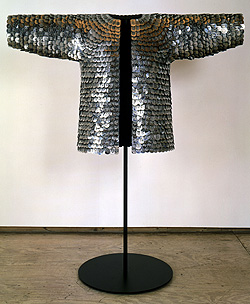War and disaster have profoundly shaped the opening years of the 21st century. In the United States and abroad, acts of violence and terrorism, as well as natural catastrophes, have resulted in large-scale destruction and displacement affecting the lives of millions.

Beginning Feb. 8, the Mildred Lane Kemper Art Museum will present “On the Margins,” an exhibition exploring the impact of war and disaster through the work of a diverse range of contemporary artists. Curated by Carmon Colangelo, dean of the Sam Fox School of Design & Visual Arts and the E. Desmond Lee Professor for Collaboration in the Arts as well as a nationally known printmaker, the exhibition will showcase more than a dozen works, ranging from prints and photographs to video and large-scale installations, by 10 artists from around the world.
Several installations play against traditional approaches to war memorial. For example, “Fallen” (2004-ongoing), by American artist Jane Hammond, comprises a large field of brightly colored leaves, each bearing the name of a soldier killed in Iraq. Similarly elegiac is “Metal Jacket” (1992/2001), by South Korea’s Do-Ho Suh, which consists of 3,000 dog tags stitched to the liner of a U.S. military jacket. “Abidin Travels: Welcome to Baghdad” (2006), an interactive video installation by the Iraqi expatriate Adel Abidin, allows viewers to become virtual tourists amidst the wreckage of his native Baghdad.
“Ghost Story” (2007), by Ireland’s Willie Doherty, and “Bouncing Skull” (2007), by Italy’s Paolo Canevari, are both haunting videos that capture the subtle, quiet horrors of life in a war zone. “The Ghost of Liberty” (2004), by Mexican artist Enrique Chagoya, uses the format of a traditional Mayan codex to investigate the wake of 9/11 through a mix of political, religious and popular imagery drawn from diverse cultures. “Strategic Museum Plan for Baghdad” (2006) by the Cuban artist Luis Cruz Azaceta, who now lives in New Orleans, ponders the fraught connections between the arts and war.
“The Difference between Black and White” (2005-06), by African-American artist Willie Cole, is a strikingly formal piece, constructed from hundreds of old shoes, that subtly alludes to the meditative mandalas of Tibetan Buddhism.
Laylah Ali, a WUSTL alumna, explores the tension between violence and social revolution in a series of simple yet meticulously crafted gouache drawings.
Finally, Martha Rosler’s “Bringing the War Home: House Beautiful, New Series” (2004) is a suite of satiric photomontages that embed militaristic imagery within the trappings of upper-middle class luxury.
Support for “On the Margins” was provided by the Charles and Bunny Burson Art Fund and by individual contributors to the Kemper Art Museum and Sam Fox School of Design & Visual Arts. An illustrated, full-color catalogue will accompany the exhibition. The volume, distributed by the University of Chicago Press, will include a foreword by Colangelo as well as critical essays by Eleanor Heartney and Paul Krainak.
“On the Margins” will open with a reception at 7 p.m. Feb. 8 in the Mildred Lane Kemper Art Museum’s Barney A. Ebsworth Gallery and remain on view through April 21. Regular hours are 11 a.m. to 6 p.m. Mondays, Wednesdays and Thursdays; 11 a.m. to 8 p.m. Fridays; and 11 a.m. to 6 p.m. Saturdays and Sundays. The museum is closed Tuesdays.
In conjunction with the exhibition, Doherty will lecture about his work at 6:30 p.m. Feb. 7 in the University’s Steinberg Auditorium adjacent to the museum. In addition, Heartney will moderate a panel discussion featuring Doherty as well as Colangelo, Cole, Hammond and Krainak. The discussion begins at 11 a.m. Feb. 9 at the Center of Contemporary Art, 524 Trinity Ave.
All events are free and open to the public. For more information, call 935-4523 or visit kemperartmuseum.wustl.edu.